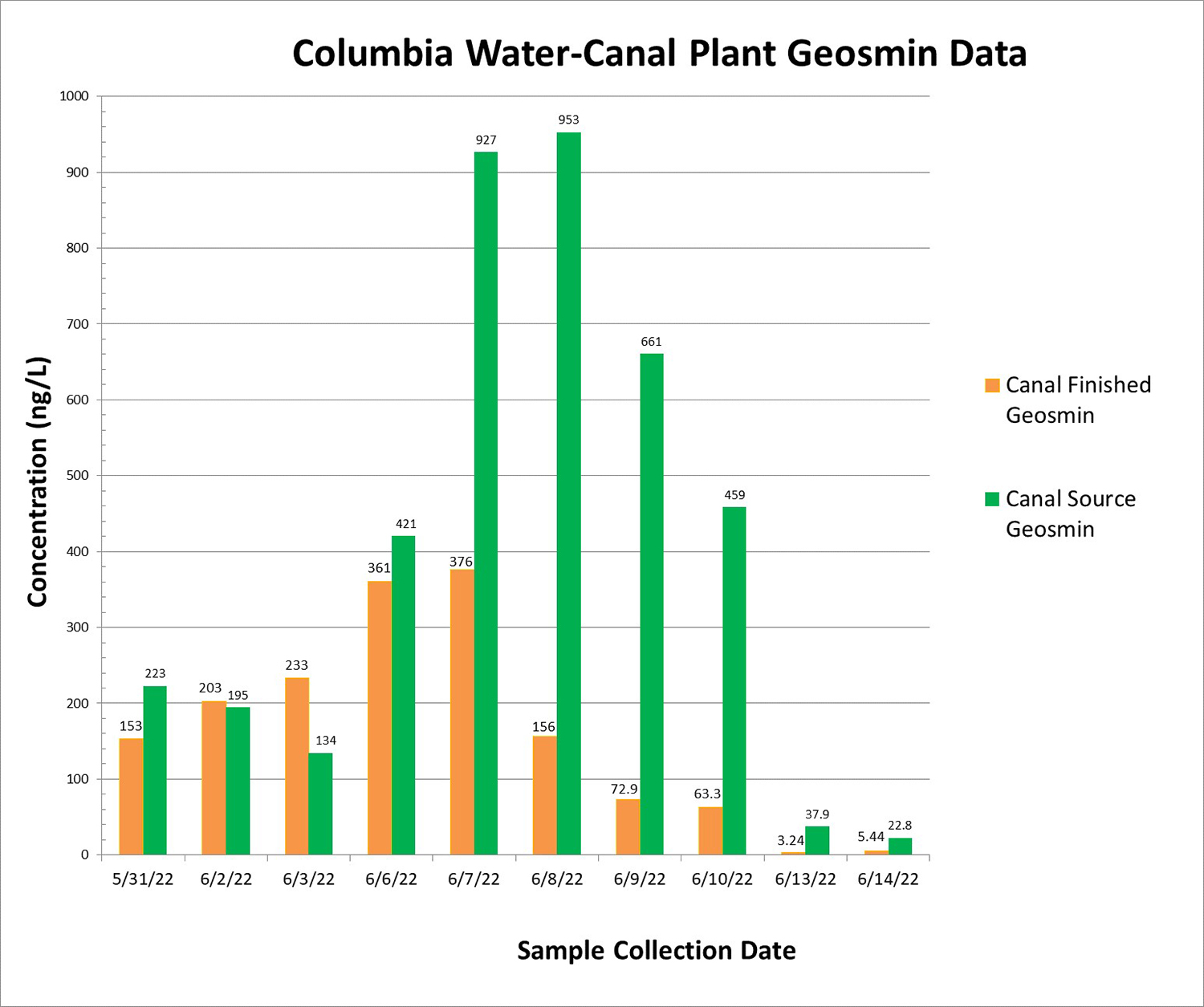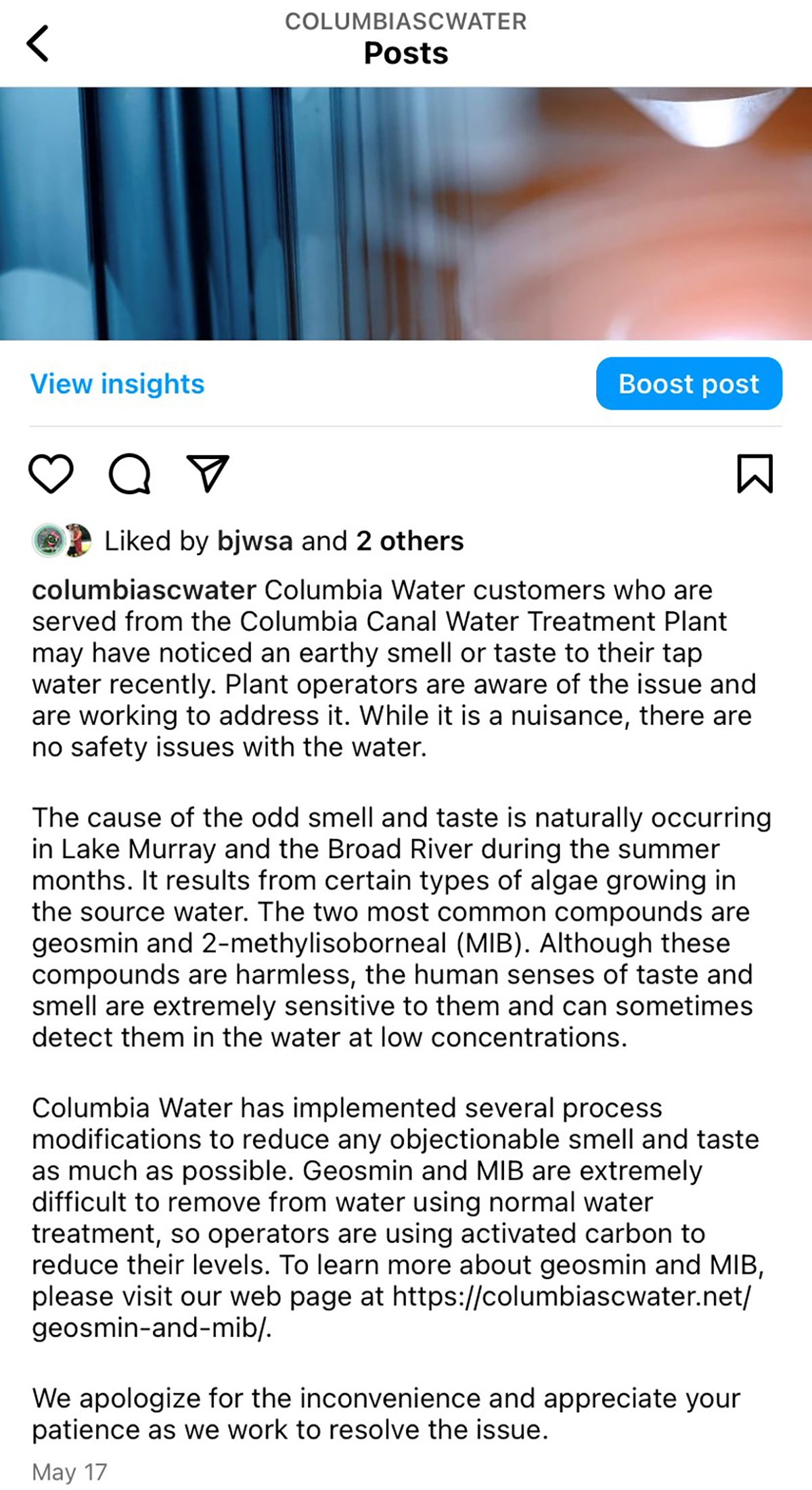In the spring of 2022, customers of Columbia Water reported a sudden change in the taste and smell of their water supply. Many called it undesirably “earthy.”
The source of the concern was geosmin, a naturally-occurring compound produced by algae. Although it is harmless and often kept at unnoticeable concentrations of less than 5 parts per trillion, or 5 ppt, conditions along the Columbia Canal, one of the system’s water sources, in May 2022 brought unprecedented changes to the geosmin concentrations. According to testing, the concentration had reached 223 ppt in the Columbia Canal source water by late May. In early June, the amount was above 900 ppt.
“We had never, in the history of the Canal Water Treatment Plant recorded over, I’ll say, 50 parts per trillion of geosmin,” said Columbia Assistant City Manager Clint Shealy.

Columbia Water used this bar graph to explain the dramatic rise of geosmin levels,
and how it was brought under control. Photo: City of Columbia.
The ability to notice the taste of geosmin varies person by person, but at these numbers, the taste was a major news event. Maintaining the safety of drinking water is a serious responsibility, Shealy said, but taste is a material concern as well.
“It’s very, very important that we don’t erode customers’ confidence in what they’re drinking,” he said.
The City of Columbia went to work to communicate as effectively about the situation as it could, and to a very wide audience. Columbia Water provides water for much more than the City of Columbia alone, serving about 415,000 people across an area of 320 square miles.
Tiffany Latimer is the customer care administrator of Columbia Water, where the call center was receiving an uptick in calls as a result of the taste issue.
“Our call center averages 20,000 to 22,000 calls every month,” she said. “In May, we handled 20,423 calls,” she said. “In June, that number increased to 24,585 calls.”
As the taste problem emerged, she said, Columbia Water was quick to brief the city’s executive management, its city councilmembers — some of whom amplified the messages on their social media channels — as well as neighboring utility systems that were also affected by the geosmin rise, and city employees. As the city worked on treatment solutions including additions of activated carbon to the water, as well as copper sulfate, which required SC Department of Health and Environmental Control approval, Latimer said they worked to remain transparent about the process.
“We wanted to make sure we provided clear, accurate, precise information, and just be honest about what was going on,” she said.
The key message emphasized that the water remained safe, she said, but beyond that they also aimed to acknowledge that the taste was objectionable, and to share steps that customers could take to help with the taste for the time being, like chilling the water, or adding lemon.
Beyond the fact sheet used to keep staff, in the call center and otherwise, up to date, Columbia Water also provided a dedicated page on its website explaining the issue, and maintained press releases and social media posts.

This May 17, 2022, Instagram post illustrates Columbia Water's early communicatons
about the water taste issue. Photo: City of Columbia.
A post from May 30 reads, in part, that the taste issue “is related to elevated algae levels in the raw water, and it is harmless. We realize, though, that this is a nuisance for our customers, and we are continuing to employ the treatment processes that have been in place since this taste and odor situation was first noticed a few weeks ago.”
The post also apologized for the inconvenience and offered the Customer Care line number for concerns.
At the same time as all of the communication efforts, the changes made to the treatment process were having an effect. The geosmin levels in the treated drinking water peaked on June 7 at 376 ppt, and was down below noticeable levels within several days. The Columbia Canal conditions that led to the record amounts of algae bloom shifted, with the source water concentrations peaking at 953 ppt on June 8 and declining quickly.
Shealy pointed to the success of getting information to the news media, and getting the news media to pick up the information and run it, as key to making the communication effort smoother than it could have been.
“If not for the news media,” he said, “we would have been inundated with calls. They helped us get the word out early.”
